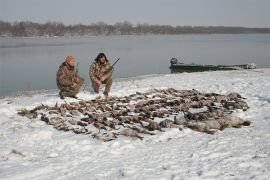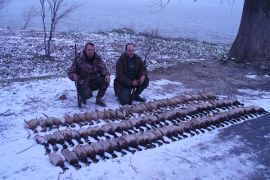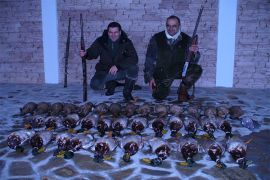Waterfowl hunting trips in Bulgaria - Hunting area село Вукан 2485
Goose hunting in Bulgaria - Hunting area село Вукан 2485
- Wildfowling - Goose hunting in Bulgaria
Wild duck hunting in Bulgaria - Hunting area село Вукан 2485
- Wildfowling - Wild duck hunting in Bulgaria
Find our discounted waterfowl hunting trips in Bulgaria
- Waterfowl hunting trips in Bulgaria directly from outfitters
» Bulgaria Hunting Trips » Waterfowl hunting in Bulgaria » Hunting area село Вукан 2485
- Hunting trips directly from outfitters:
Waterfowl hunting trips in Bulgaria
Hunting area село Вукан 2485
Book Your Waterfowl Hunts in Bulgaria
Waterfowl hunting trips in Bulgaria
Waterfowl hunting in Bulgaria
- ✓ Waterfowl hunting in Bulgaria
- село Вукан 2485
Waterfowl hunting in Bulgaria
Wild ducks hunting trips in Bulgaria
Wild duck hunting is one of the coldest and most exciting types of wing shooting in Bulgaria. There are three types of duck hunting. The first kind is at flight, early in the morning and at dusk. The second kind is with fake lures at the resting spots (reservoirs, dams, rivers and runoff water). The third kind is walked up hunting along river banks, canals and streams.
When hunting in the early hours of the morning, the hunters have to be at the hunting spots before dawn. The birds move from ther feeding spots towards the resting spots. Those are normally large dams and high-water rivers. Wearing warm clothes is recommended, but using camouflage coverings is a must, due to the fact that these birds have a sharp eyesight and a very acute sense of hearing. It is a good idea for hunters to use auditory decoys, so as to direct the birds towards themselves. You may use retriever dogs (Golden Retrievers, Labradors, Drahthaarts, Kurzhaarts and Setters). The dogs need to be very disciplined, compliant and to obey the command Stay in place!. Dogs with experience trace the shot birds by themselves and swiftly retrieve them for their guide.
During the hunts at dusk, it is advisable to lie in wait for the ducks at their feeding spots.
Those are: surface runoff areas (overland flow), harvested fields (rice fields), shallow streams, flooded corn fields (grooves filled with water). It is mandatory to use auditory decoys, so as to direct the birds towards the desired places. It is advisable to use retriever dogs, due to the fact that the hunt takes place in the darker hours of the day. For this kind of wing shooting in Bulgaria, using Drahthaars and Kurzhaars brings greater success. They are able to find the shot birds visually as well as by smell, while Labradors and Golden Retrievers tend to track the bird visually and are more suited for hunting at wide open water areas (reflective water surfaces).
Walked up hunting is the second method of hunting ducks. That is an emotion-filled outing involving long hikes, which is why the hunter must be in excellent health. This kind of hunt is most sucessful when the bigger dams in the area freeze over. Smaller canals and rivers do not allow the water to freeze even at temperatures below - 15 degrees. Birds are aware of that and they find favourable conditions to rest and eat. It is recommended to start this type of hunt at 6 am, and it can last until as late as 5 pm. It may then be combined with an evening hunt at dusk. Combined, the two types of hunt can bring wonderful results. During walked up hunts, it is good to use a guide who knows the places where the birds rest during the day. Once you near the resting spots, you need to move quietly and stay low. You need to use the surrounding vegetation as a cover while you approach the birds and use the element of surprise. It’s possible to lift between 20 and 50 birds into the air at one of these spots. When moving along a riverbank or canal, you need a disciplined dog that walks no more than 15 - 20 steps ahead of you. Once you near the resting spots, the dog must obey the command Heel! or Behind me! so as not to lift the resting game birds. In Bulgaria, the most widely established dog breeds are Drahthaar and Kurzhaar. Once the birds have been shot, the dogs must retrieve the birds from water as well as dry land under the command Retrieve!. The dog must be able to maneuvre through obstacles (water obstacles, fallen trees, ponds, etc.) - in other words, it needs to be hardy while retrieving.
The third kind of hunting is by lying in wait for the birds at their resting spots. Those are: large reservoirs (dams), surface runoffs. It is mandatory to use lures (decoys). It is advisable to put between 40 and 100 duck decoys into the water. It is good to have two or three pairs of spinning wing decoys (mojos). You may use mobile duck decoys with electric motors, so as to create the illusion that the birds are moving. The hunters need to have made a temporary hiding place at the river bank. It must blend in with the terrain so as not to arouse suspicion in the birds. A boat camouflaged with reed vegetation can be used for the same purpose. Hunting by boat allows the hunters to choose the hunting spots for themselves. When using decoys in such cases, they need to be mobile, with built-in chords and weights (so that they can be thrown directly from the boat).
Mallard Identification
Male has green head with olive green bill. Wings of both sexes have purplish / blue speculum and white underside. Concentrations of mallards are typically found near agricultural grain fields that are situated near wetlands or river courses. This species nest throughout country and especially in The Danube plain. Mallards typically return to feeding areas so scout your hunting area to locate where the birds are feeding. A mallard call can be quite successful in luring this bird to decoy spreads.
Geese hunting trips in Bulgaria
Goose hunting involves early mornings and very cold treks. This type of wing shooting in Bulgaria is effective while the birds are in flight in the morning and late afternoon.
In the morning the geese are stalked by the places they have rested at (big lakes and rivers). Places that offer a vantage point are chosen, allowing the hunters pick the birds off before they manage to climb beyond the hunters’ range. The best distance for shooting geese is about 30 to 40 m. This is a very resilient bird and that is why bigger pellets must be used (№ 1, № 0, № 2/0 and № 4/0).
In the late afternoon the geese can be stalked by the places they rest at overnight (big lakes and rivers), usually by the edge of the water. The use of goose calls is recommended in order to lure the birds in the desired direction. At dusk the shooting distance can range from 15 to 30 m.
The second way to hunt geese is at their feeding spots.These are fields with wheat crops still in the early stages of their growth, the main food source for the geese. After the field is chosen a hideout that blends in with its surroundings is constructed. The hideout can be set up some time before the hunt allowing the birds some time to get accustomed to its presence.
Decoys with and without spinning wings can be used as well as 3 artificial magpies and 50 to 100 static birds, mimicking a flock of feeding and resting geese. Other types of decoy birds can be used in order to create the illusion of a peaceful field. Shooting distance ranges between 15 to 30 m.
Hunters can use goose calls to direct the flocks to the desired spots and because the birds drop down from great heights the hunters must have patience and wait for them to come within range. Shooting is under the command of the guide (Now! etc.). These are powerful birds with good plumage. If shot at prematurely there is a chance to miss or wound the goose.
A retriever dog can be used. It must be well-disciplined and obey the command Stay! and must be kept inside the hideout. Geese hunts can last the entire day and the hunt itself is static and in cold weather.That is why heat insulating clothes, warm winter boots and neoprene socks are a must for this type of wing shooting in Bulgaria.
When to hunt Goose Geese?
Goose hunting season in the Bulgaria starts in Oktombre. It gains tempo when the geese begin their migration from Russia to warmer places.
- BOOK YOUR HUNT IN BULGARIA
Обикновена дива патица
(зеленоглавка)
(Anas platyrhynchos L.)
Срокове на ловуване
Ловът на дивите патици е разрешен от 1 октомври до 31 януари.
Препоръчителни патрони със съчмен заряд за отстрел на дива патица
Екипът на БГ Ловци (bghunters.com) Ви препоръчва следните патрони:
- Препоръчителни патрони - 32g. за 12 кал.
- № на сачмите - 5, 3
- Разстояние - 35 метра
Разпространение на дивата патица - зеленоглавка - юрдек
Обикновената дива патица е широко разпространен вид в Северното полукълбо. Среща се в Европа, Азия, Северна Америка, Южна Гренландия и Северна Африка.
У нас е постоянен и прелетен ловен вид. През лятото остава да гнезди в малки количества, но през зимата масово идва от север и се задържа дълго. Около язовирите и по-големите водоеми при мека зима остава до пролетта. В края на февруари - началото на март започва пролетния прелет и през нашата страна преминават патиците, които са зимували в по-южните райони.
Описание на дивата патица - зеленоглавка - юрдек
Характерно за обикновената дива патица е, че при нея има добре изразен полов, сезонен и възрастов диморфизъм.
Мъжка обикновена дива патица
Оперението на мъжката патица през брачния период е много ярко. Главата и шията са тъмнозелени, с метален блясък. На шията има бяла огърлица. Гърдите са кафяви, гърбът сиво-кафяв, а тялото отдолу е светло-сиво, с напречни вълновидни препаски. Задната част и надопашието са черни със зелен блясък. Огледалото й е трицветно - стоманено-синьо с виолетов оттенък, оградено от двете страни с черна и бяла ивица. На опашката има две извити перца. В извънбрачно оперение мъжките патици приличат на женските, но горната страна на тялото им е едноцветна кафява, опашката е по-светла, главата по-черна, гушата по-тъмна, а клюнът - жълтозелен.
Големината на мъжките патици варира твърде много. Тя достига на тегло до 1,7 kg (средно 1 kg), а на дължина - от 50 до 55 cm.
Женска обикновена дива патица
Женската патица е по-дребна - от 0,750 до 1,300 kg.
Тя няма добре изразен сезонен диморфизъм. Общият тон на нейното оперение е сиво-кафяв или ръждиво-жълт с множество черни петна и щрихи по цялото тяло. Гърлото е жълто-бяло, като крилното огледало е както при мъжкия. Надкрилията са малко по-тъмни. Клюнът е с розов оттенък и тъмна ивица по средата.
Младите птици приличат на женските, но са по-тъмни и еднообразно оцветени.
Местообитания на дивата патица - зеленоглавка - юрдек
Обикновената дивата патица обитава разнообразни влажни зони от лесотундрата до пустините и планините, което обяснява широкият й ареал на разпространение. Съвсем естествено е нейното предпочитание към водните площи, обрасли с гъста крайбрежна растителност, в която те гнездят и се укриват по време на линеенето. Среща се и в културните ландшафти, понася спокойно близостта на човека. Избягва бързо течащи реки и бедни на хранителни вещества екосистеми. Популацията на дивата патица, има по-висока численост в равнините, като най-многобройна е в блатата и езерата край р. Дунав и по Черноморското крайбрежие.
Храна на дивата патица - зеленоглавка - юрдек
Дивата патица отначало храни малките си през деня с малки насекоми. По-късно, когато на патетата израстат роговите израстъци по клюна, те започват да се хранят и през нощта, като прецеждат тинята. Храната на възрастните патици е твърде разнообразна. Те ядат растителна и животинска храна - зелени части на водни растения, ларви и възрастни насекоми, мекотели, нерядко риба и вегетативни части и семена на културни растения и др.
Биология на дивата патица - зеленоглавка - юрдек
Половата зрелост при зеленоглавката настъпва на една година. Тя образува двойки, които при патиците, зимуващи у нас, се оформят още през есента, а при прелетните - през зимата в местата на зимуване. Ятата се запазват до пролетта. Сватбуването е съпроводено със специфична брачна игра. Свободните женски патици се стараят да привлекат някой паток от тези, които вече са се чифтосали.
Женската патица построява гнездото си от сухи растителни части в непосредствена близост до водоемите. То е добре скрито в тревата, корените на дърветата, в блатна растителност или храстите.
Рядко дивата патица гнезди по дърветата в стари гнезда на чапли или вранови птици. В продължение на 10 дни, най-често привечер, женската снася по едно яйце. След всяко яйце женската се задържа все повече в гнездото, но истинското мътене започва след снасянето на последното яйце. Въпреки че първите яйца са вече леко замътени, малките патенца се излюпват след 26 дни, в продължение на около 10 часа. Отначало женската патица напуска гнездото сутрин и вечер, за да се храни, но след това лежи много упорито, дори и в случай на опасност.
След излюпването малките бързо укрепват (около 12-16 часа), след което майката ги повежда към водата. Ако патицата е мътила на дърво, малките сами скачат от гнездото без да се наранят. Майката с малките се укрива в гъстата водна растителност или почива на брега, скрита в храсталаци, треви, бурени и др. Мъжките по това време започват интензивно да линеят, поради което се укриват в подходящи места, където трудно могат да бъдат открити.
Естествени неприятели на дивата патица - зеленоглавка - юрдек
Техните гнезда и люпила се унищожават от хищници, хора, а твърде често и от наводнения. Патиците гнездят и в селскостопански култури, ливадите и пасищата около водоемите и при прибирането на реколтата техните гнезда се унищожават.
Ловностопанско значение на дивата патица - зеленоглавка - юрдек
Според ловните таксации видът е с най-широко разпространение и многочисленост от всички патици. Зеленоглавата патица е голямо ловностопанско значение. Тя е интересен обект на ловуване, има вкусно месо и по време на прелетите се среща в значително количество в цялата страна. У нас зимуват средно около 100 хил. зеленоглавки, но тендецията е към намаляване на числеността й.



